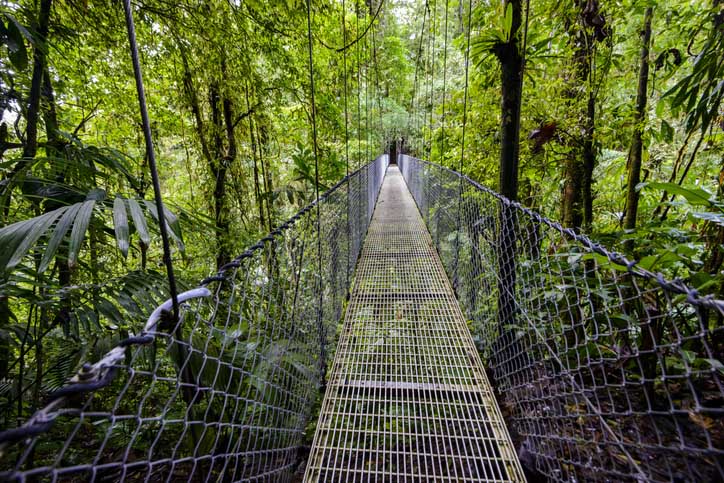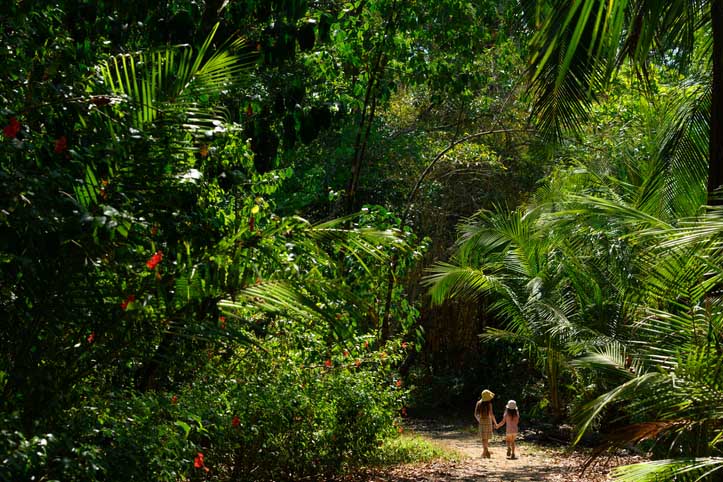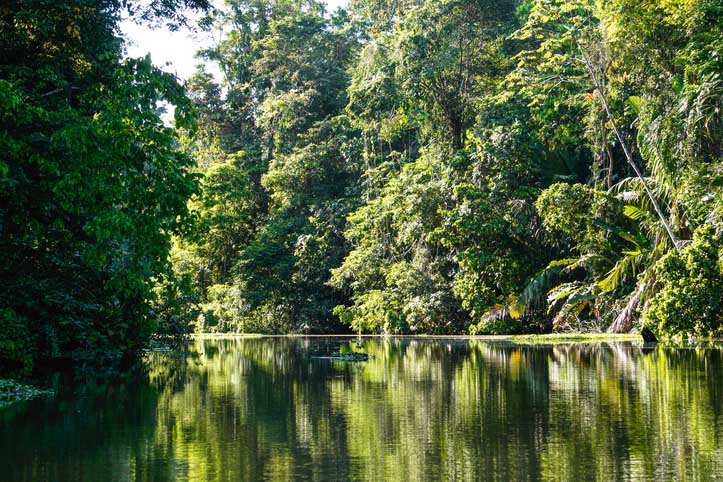The poster-child for all things eco, Costa Rica is the star pupil in the world’s ecotourism class. Sandwiched between Nicaragua and Panama, this tiny Central American country prides itself on the conservation and protection of its wonderfully biodiverse environment. The country is home to half a million species and one quarter of the country’s wild lands are protected by law. Boasting 26 national parks, 58 wildlife refuges, 32 protected zones, 15 wetland areas, 11 forest reserves, and eight biological reserves – there is a lot to choose from when it comes to planning an ecotourism adventure here. Costa Rica’s main eco-points come from the sheer amount of protected zones; which promote biodiversity, as well as sustainable development practises and eco-incentives that bring economic benefits to local areas. Read on for a roundup of five of the best places in the country, that all score highly on the eco-scale, so that you can experience the best of Costa Rica’s ecotourism…
- Arenal Volcano National Park
- Caño Island
- Corcovado National Park
- Monteverde Cloud Forest Reserve
- Tortuguero National Park
1
Arenal Volcano National Park
Dominating the fertile northern lowlands, it is impossible to talk about Costa Rica ecotourism without mentioning Arenal Volcano National Park. Explore the maze of hiking trails that zigzag through the forest at the base of the volcano, on foot or on horseback. You can wander through the protected national park using its 13 hanging bridges, while the more adventurous might want to explore the canopy by zip wire. Rafting, canyoning and mountain biking are just a few of the other activities that you can do in the surrounding area. Explore the biologically diverse rainforest, without leaving any kind of carbon footprint, knowing that visiting the park is actively helping to protect it.

2
Caño Island
Considered one of the top eco-destinations in Costa Rica, Isla del Caño has to be included in this list. Only nine miles from the Pacific coast and Corcovado National Park, all two square miles of the island is a biological reserve, protecting the numerous different species that call the area home. Dive into the protected waters for world-class snorkelling and scuba diving, including superb deep freshwater experiences with large schools of jacks, barracudas, manta rays and sharks. Visitors have to sign in at the ranger station and permits are required, which limits the amount of people on the island and provides economic benefits that go towards the continued protection of the reserve. Wander the stunning beaches (the lush inland is off limits, to help protect its animals inhabitants), gazing out at the Pacific Ocean and catching glimpses of animals hiding in the trees. The bird life on the island is incredible too; keep your eyes peeled for cattle egrets, common black hawks, ospreys, brown booby and Northern phalaropes.
3
Corcovado National Park
You’ll find the 43,000-hectare Corcovado National Park on the remote Osa Peninsula. The crown jewel of Costa Rica’s national park system, the park protects the largest remaining expanse of primary rainforest on the Pacific coast of Central America, taking up 40% of the Osa Peninsula and containing over 250,000 species. Home to some of the country’s best eco-lodges and eco-experiences, staying and playing here is nothing but eco-friendly. Explore the region’s different ecosystems - which include rainforests, swamps, rivers, lagoons, marshes and beaches - all the while searching for the endless amount of wildlife that live here, including more than 400 species of birds and over 100 species each of amphibians and mammals. Thanks to the park’s protected status, a plethora of endangered species - such as Baird's tapir, the white-lipped peccary, jaguars, ocelots, crocodiles, giant anteaters, scarlet macaws and the harpy eagle - have found sanctuary under its green canopy. The seas shelter three species of marine turtles and you can witness the migration of humpback whales in December and January. Go hiking, diving and snorkelling, or take a boat trip to La Llorona Waterfall. Most of the electricity in the park is solar powered and all visitors need permits to enter - when it comes to ticking eco-boxes, this park covers all of the bases.

4
Monteverde Cloud Forest Reserve
A model for ecotourism and sustainable development, Monteverde Cloud Forest Reserve is one of the most coveted ecotourism destinations in the whole of Costa Rica. Located in the north of Puntarenas province, this 26,000 acre biozone is brimming with a wonderfully diverse amount of wildlife and plant life. Shrouded in a misty blanket, the cloud forest is located 5,249ft above sea level and is home to an incredible two-and-a-half percent of the world’s biodiversity in eight distinct biological zones. If you are lucky, you’ll see jaguars, toucanets, pumas, monkeys and red-eyed tree frogs, plus many more. Explore the forest on foot on one of the many hiking trails that wind through the trees, or take to the canopy for a bird’s eye view on a zip-line tour or skywalk, across a series of bridges suspended in the trees. Amazing ecolodges boost to the eco-credentials of the park – adding to Costa Rica’s ecotourism score as a whole.
5
Tortuguero National Park
Framing Costa Rica's northern Caribbean coast, Tortuguero National Park protects one of the last large areas of tropical rainforest in Central America. Excellent lodges provide some of the best eco-friendly accommodation, while expert naturalist guides can take you out on foot or by boat to explore the waterways and thick jungle, teaching you more about the surrounding environment. Other eco-initiatives include volunteering to protect the Tortuguero beaches where huge numbers of green turtles come ashore to lay their eggs (between June and November). The protected beaches are a prime nesting ground for the endangered green turtles, which come ashore to lay their eggs between June and October. Other animals benefit from the protected status of the park too. The slow-moving tropical rivers are home to river otters and caimans, and in the trees you’ll see three different species of monkeys and birds, such as toucans and eight species of parrot.














